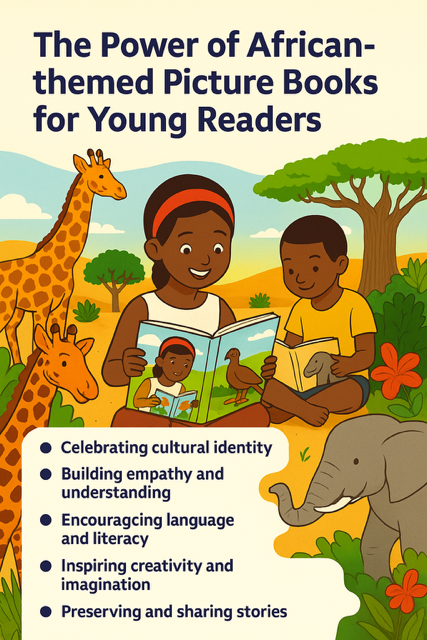The Power of African-themed Picture Books for Young Readers
21st May, 2025

Picture books are more than just colorful pages and fun stories—they’re windows into the world, shaping how children see themselves and others. For young readers in South Africa and across the continent, African-themed picture books hold immense power. These stories, rooted in African cultures, landscapes, and experiences, foster pride, spark imagination, and build empathy. Here’s why African-themed picture books matter for kids, parents, and communities.
1. Celebrating Cultural Identity
African-themed picture books showcase the continent’s diverse cultures, languages, and traditions. From the vibrant markets of Johannesburg to the rolling hills of KwaZulu-Natal, these stories reflect the lives of African children. Books like Gogo’s Basket or The Herd Boy celebrate everyday moments—whether it’s weaving with a grandmother or herding sheep—helping kids feel proud of their heritage. When children see their own lives in books, it boosts self-esteem and a sense of belonging.
2. Building Empathy and Understanding
Stories set in African contexts introduce young readers to different communities, histories, and ways of life. A child in Cape Town might read about a fisherman in Ghana or a Maasai herder in Kenya, learning to appreciate the diversity within Africa. These books also counter stereotypes by showing the richness and complexity of African life. For non-African readers, they provide a glimpse into a world that’s often misrepresented, fostering empathy and global awareness.
3. Encouraging Language and Literacy
Many African-themed picture books incorporate local languages, such as isiZulu, isiXhosa, or Swahili, alongside English. This bilingual approach supports early literacy by introducing kids to new words and rhythms. Books like Funky Chickens use playful language to make reading fun, while others, like South Africa: A to Z, teach the alphabet through culturally relevant themes. For multilingual households, these books are a treasure trove for language development.
4. Inspiring Creativity and Imagination
The vivid illustrations and storytelling in African-themed picture books ignite children’s creativity. Whether it’s the colorful patterns of Ndebele art or the sounds of a mbira in Where’s My Mbira?, these books stimulate the senses. They encourage kids to draw, tell their own stories, or even explore their surroundings with fresh eyes. By grounding imagination in familiar settings, these books make creativity accessible and relatable.
5. Preserving and Sharing Stories
Oral storytelling is a cornerstone of many African cultures, and picture books help preserve these traditions in written form. They pass down folktales, proverbs, and values to the next generation while making them accessible to a global audience. For parents and educators, reading these books is a way to share cultural wisdom and spark meaningful conversations with kids about history, family, and identity.
African-themed picture books are more than stories—they’re tools for empowerment, education, and connection. They help children see the beauty in their own lives, understand others, and dream big. By filling bookshelves and classrooms with these titles, we nurture a generation of confident, curious, and compassionate readers. Let’s celebrate the power of African stories and make them a staple in every child’s reading journey.
Do you have a favorite African-themed picture book? Share it in the comments, or tell us how these stories have inspired your kids! Support local authors and illustrators by picking up an African-themed book today.
